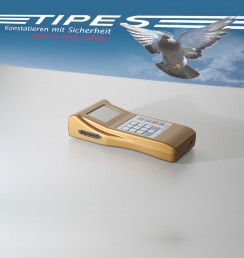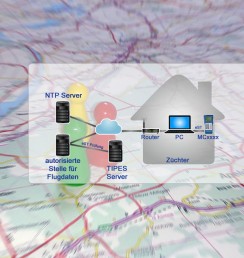
The introduction of TIPES
Here is an article written several years ago, at my request, by a young German friend of mine, Rene Foertsch. I knew that Rene was not keen on using ETS when it was first….
The introduction of TIPES
Here is an article written several years ago, at my request, by a young German friend of mine, Rene Foertsch. I knew that Rene was not keen on using ETS when it was first introduced and then I learned that he, and his father who he races with, had bought a TIPES unit.

I asked him if he would write for us about his experience. Then, and now, there were many in this country who felt intimidated by ETS – something new, something that they did not understand, something they were not familiar with and so I asked Rene if he would recount his experience. I knew it would be genuine and honest, because that is what Rene is, and that is what we have here a genuine, honest account of ETS in use. (Many may not be familiar with the name TIPES and would perhaps be surprised to learn that it is one of the most common ETS systems available in Germany. It is also available in the UK HERE )
Nigel Lane
The introduction of TIPES
I use “TIPES” in this article for electronic clock because it is the system we use. I can only write about TIPES, but more or less everything is valid for other electronic clocks as well.

Recalling the time when I was first doing the calculations for working out the results of a race in our club I can say that in that time, some 15 years, a lot has changed. Back then we had a card for each clocked pigeon on which the speed had to be put in through rather sophisticated math. It took us like three hours to finish everything for a race in which 300 pigeons from our club had been entered. (As they worked on 33% prizes this would mean processing 100 pigeons in the Club alone.) A great improvement came about eleven years ago when we for the first time had the chance to send just a sheet with the arrival times of each fanciers pigeons to an organization called “RIRO”; even today they are still putting together the prize lists for us. (Results are produced by a private company, RIRO, on a Federation basis and published on the Internet.) But still we had to open the clocks and look through the bands, which of course were usually difficult to read due to bad imprinting etc.


Motz-Computer GmbH
Today in our marking station TIPES is doing all the work. We usually meet at six p.m. after a race on the same day. Everybody is handing in his electronic devices with his arrival times on them. Already after having taken in a few of these results roughly an end time for the race can be estimated (in our federation a race ends after 33% of the pigeons have arrived at home). By about 20 minutes past six all the work for nearly 20 fanciers is done and the computer is calculating a prize list. Latest at seven p.m. every fanciers holds a printout of his pigeons arrival times and a complete prize list for the marking station in his hands. Half an hour later, after speculations over whether the other clubs which have taken part may have done better or worse, our marking station’s president is doing a “round-call” from which he receives the start and end times in their area with exact data of racing speed. We are getting the official end result over the Internet on Tuesday, two days after the race. Until then, we already can say + – one minute who will have won the race and how long the prize time will be. A great part of the advantage TIPES brings with it therefore is a saving of precious time. After having basketed the pigeons and waited for their arrival much time is gone already. Doing the results does not need to be another parasite to leisure time with family and friends. But this by far is not everything TIPES does. I doubt that anyone reading this article has not at least once heard or been part of arguments about whether the clocks were set properly, whether the times were read correctly from the bands or who was to blame when a clock had stopped to run. TIPES gives precise times, a clear overview and does not allow mistakes resulting from false reading or inaccurate running clocks. Who can say that his clock shows the exact time after a period of three days when it is stopped?

Finally TIPES is the fairest way of timing pigeons in. What is the justification of calculating the time span between a pigeon’s entering and the point of manual clocking into race speed? A pigeon has finished its race when it entered the loft. It must be timed at this point! Obviously there is the fact that when TIPES is introduced some fanciers will have it and some will not. One should not forbid the use of TIPES but think about ways out of this self-made dilemma. We have not done this here, but what about granting every manually clocked pigeon 5 seconds? The opinions in our marking station when we for the first time had the chance of timing pigeons electronically have been pretty unanimous. Of course a few things that always are brought up against it were mentioned – they will be mentioned here as well – but in the end everybody said that who wants to try it should be allowed to. The aspect that some fanciers are impaired in walking added to this point of view, because it is harder for them to catch pigeons quickly. The group of our marking station, about one third in the beginning, that decided to buy it also got a cheap laptop and a printer as well. Everything went fine. Even today a few fanciers still are clocking pigeons manually. This is not a problem. The fear that when the first fanciers have TIPES everyone will need it is not justified. Everyone is free to do what he wants here, even after about 8 to 9 years of TIPES.


TIPES Production
The suspicions connected to timing electronically never proved true in our whole federation. The first one is that cheating may be possible for some computer technician. All I want to say is: Do I need a computer specialist if it is enough to have a screwdriver? One thing I can say for sure: Cheating with TIPES is much more difficult than cheating with manual clocks. As far as I know there is not one known case in Germany. The second one is that TIPES may be unreliable or difficult to use for older fanciers. In all the years we had not to annul one single race or do something similar. Every computer problem that has arisen we could solve in a few minutes time. There have been no malfunctions. All the maintaining one has to do is a battery change after 4 to 7 years. And why should there be difficulty in using it? All one has to do it plug it in and then take the portable device to the marking station.
If you start talking about electronic timing never forget to try to tell apart rumors from facts. There are opinions galore out there but most of them are opinions from fanciers who never even have tested such an electronic clock. I have tried to give you a short insight into the way things are going after TIPES is introduced. Honestly, even I was not amused when they came up with the idea to use TIPES. But now I am convinced that it is a good way, the best way of timing pigeons. We here have made no bad experiences at all.
Rene Foertsch
Please contact us immediately if you are interested to become a partner!




